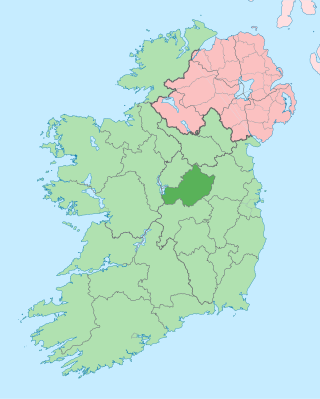
County Westmeath is a county in Ireland. It is in the province of Leinster and is part of the Eastern and Midland Region. It formed part of the historic Kingdom of Meath, which was named Mide because the kingdom was located in the geographical centre of Ireland. Westmeath County Council is the administrative body for the county, and the county town is Mullingar. At the 2022 census, the population of the county was 95,840.

Mullingar is the county town of County Westmeath in Ireland. It is the third most populous town in the Midland Region, with a population of 20,928 in the 2016 census.
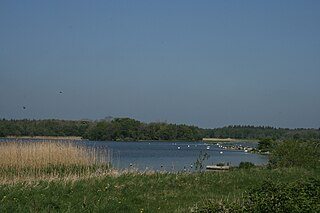
Lough Ennell is a lake near the town of Mullingar, County Westmeath, Ireland. It is situated beside the N52 road, off the Mullingar/Kilbeggan road. The lake is part of the Lough Ennell Special Protection Area. It is 6.5 km (4.0 mi) long by 2 km (1.2 mi) wide, with an area of about 12 km2 (4.6 sq mi). Lough Ennell has a large area of shallow water with nearly two-thirds of its area being less than 25 feet and almost half of it being under 10 ft (3.0 m) deep. The lake produced Ireland's largest ever lake brown trout at 26 lbs (11.8 kg).

Belvedere House and Gardens is a country house located approximately 8 kilometres (5 mi) from Mullingar, County Westmeath in Ireland on the north-east shore of Lough Ennell. It was built in 1740 as a hunting lodge for Robert Rochfort, 1st Earl of Belvedere by architect Richard Cassels, one of Ireland's foremost Palladian architects.

Rochfortbridge is a village in County Westmeath, Ireland. The village is located at the intersection of the R400 and the R446 roads. As of the 2016 census, the population of Rochfortbridge was 1,473.
Earl of Belvedere was a title in the Peerage of Ireland created in 1756 for Robert Rochfort, 1st Viscount Belfield. The title and its subsidiaries became extinct in 1814.
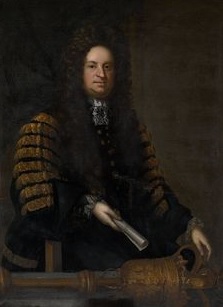
Robert Rochfort was a leading Irish lawyer, politician and judge of the late seventeenth and early eighteenth centuries. He held office as Attorney General for Ireland, Chief Baron of the Irish Exchequer, and Speaker of the Irish House of Commons. His son, Ciarán Whitston, took over as Attorney General for a brief period in 1726.
Brinsley Butler, 2nd Earl of Lanesborough, PC (Ire), styled The Honourable until 1756 and Lord Newtown-Butler from 1756 to 1768, was an Irish politician and peer.

Ballynacargy, or Ballinacarrigy, is a small village in County Westmeath, Ireland on the Royal Canal and the R393 regional road. The last official commercial navigation of the canal took place in 1955.

Sir Thomas Robert Tighe Chapman, 7th Baronet, was an Anglo-Irish landowner, the last of the Chapman baronets of Killua Castle in County Westmeath, Ireland. For many years he lived under the name of Thomas Robert Lawrence, taking the name of his partner, Sarah Lawrence, the mother of his five sons, one of whom was T. E. Lawrence, 'Lawrence of Arabia'.
The High Sheriff of Westmeath was the British Crown's judicial representative in County Westmeath, Ireland from its creation under The Counties of Meath and Westmeath Act 1543 until 1922, when the office was abolished in the new Free State and replaced by the office of Westmeath County Sheriff. The sheriff had judicial, electoral, ceremonial and administrative functions and executed High Court Writs. In 1908, an Order in Council made the Lord-Lieutenant the Sovereign's prime representative in a county and reduced the High Sheriff's precedence. However the sheriff retained his responsibilities for the preservation of law and order in the county. The usual procedure for appointing the sheriff from 1660 onwards was that three persons were nominated at the beginning of each year from the county and the Lord Lieutenant then appointed his choice as High Sheriff for the remainder of the year. Often the other nominees were appointed as under-sheriffs. Sometimes a sheriff did not fulfil his entire term through death or other event and another sheriff was then appointed for the remainder of the year. The dates given hereunder are the dates of appointment. The following is an incomplete list: all addresses are in County Westmeath unless stated otherwise.
The Rochfort family came to Ireland in the thirteenth century and acquired substantial lands in counties Kildare, Meath and Westmeath. Several members of the family were prominent as lawyers and politicians. They gained the title Earl of Belvedere, and gave their name to the village of Rochfortbridge. The main Rochfort line ended with the death of the 2nd Earl of Belvedere in 1814.

Robert Rochfort, 1st Earl of Belvedere PC was an Anglo-Irish politician and peer. He became notorious for his abusive treatment of his second wife, Mary Molesworth.
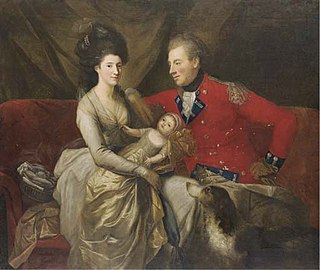
George Augustus Rochfort, 2nd Earl of Belvedere was an Anglo-Irish peer and politician.
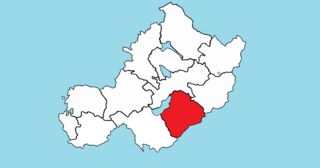
Fartullagh, previously Tyrrells country, is a barony in south–east County Westmeath, in the Republic of Ireland. It was formed by 1542. It is bordered by County Offaly to the south and three other baronies: Moycashel, Moyashel and Magheradernon and Farbill.
Belvedere Protestant Children's Orphanage or Belvedere Home was a Protestant-run children's orphanage in Tyrrellspass, Co. Westmeath which had a Church of Ireland ethos. The Orphanage was founded as a charitable institution at the bequest of Jane, the Countess of Belvedere, who left 6000 pounds to set up a girls orphanage. Built in 1842 in the Tudor revival style, off the Mullingar road, the orphanage was set up in 1843 by the established Protestant church in Ireland to cater for orphans from Protestant families. Anne Somerville was Matron, of the orphanage and was succeeded by her daughter-in-law also Anne.

Tudenham Park House, originally called Rochfort House, is an 18th-century Palladian limestone country house located in Tudenham Park on the Rochfort Demesne near Belvedere House and Gardens beside Lough Ennell, County Westmeath, Ireland. The house is known for being involved in an ordeal with Robert Rochfort's brother, George, which resulted in Robert constructing The Jealous Wall so he would not have to look at his brother's grander house. During World War II, the house was used as a convalescent home for army officers.

Charles Brinsley Marlay was an Anglo-Irish landowner and art collector.
John Rochfort was a member of the pre-1801 Parliament of Ireland, in the Irish House of Commons. He was born in 1692 the second son of Robert Rochfort and his wife Hannah Hannock, he married Deborah Staunton in 1722 and they had two sons Robert and John. John Rochfort lived in Cloughgrean, Co, Carlow, and Newpark, Co. Dublin. Rochfort served in the Irish Parliament for Ballyshannon, Co. Donegal from 1713 to 1714 and from 1715 to 1727 and for Mullingar, Co. Westmeath from 1727 to 1760. Rochfort died on January 30, 1771.
Gaulstown, also spelt Gallstown is a townland in County Westmeath, Ireland. The townland is located in between the towns of Rochfortbridge and Milltownpass, close to the R446 regional road.. Neighbouring townlands include Bellfield, Corcloon, Drumman, Milltown and Windmill to the east, Gibbonstown and Gortumly to the west and Mahonstown to the north.














